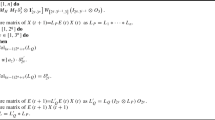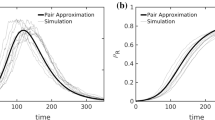Abstract
The mathematical theory of epidemics borrows its fundamental notions from epidemiology. These notions encompass the division of the population of individuals into compartments and thereafter the classification of epidemics in models like SIR (susceptible-infected-removed). Unlike in biology, a broad number of epidemics are spread under the action of rational and intelligent malicious individuals, called attackers. The centralized control of such epidemics implies that a network defender is in conflict with the attacker and therefore should be modeled by a zero-sum noncooperative game theoretic concept. We design a new zero-sum partially observable stochastic game (POSG) theoretic framework in order to capture the interactions between network defender and an attacker. More, our model takes into account random node state transitions. The particularity of our model is that even though the attacker knows the state of the network, which is not the case for the defender, she cannot infer the defender’s actions. The tractability of the solution of classical POSG is improved by the mean of value backup iteration. We prove that the value backup operator converges even in our particular POSG coupled with a compartmental epidemic model.

Similar content being viewed by others
References
Ansari A, Dadgar M, Hamzeh A, Schlötterer J, Granitzer M. Competitive influence maximization: integrating budget allocation and seed selection
Antonakakis M, April T, Bailey M, Bernhard M, Bursztein E, Cochran J, et al. (2017) Understanding the Mirai Botnet. In: 26th USENIX security symposium, pp 1093–1110. Available from: https://www.usenix.org/conference/usenixsecurity17/technical-sessions/presentation/antonakakis
Basu A, Stettner L (2015) Finite- and infinite-horizon Shapley games with nonsymmetric partial observation. SIAM J Control Optim 01(53):3584–3619
Bernstein D, Givan R, Immerman N, Zilberstein S (2002) The complexity of decentralized control of Markov decision processes. Math Oper Res 27(4):819–840
Chakrabarti D, Wang Y, Wang C, Leskovec J, Faloutsos C (2008) Epidemic thresholds in real networks. ACM Trans Inf Syst Security. 10(4)
Chatterjee K, Doyen L (2011) Partial-observation stochastic games: how to win when belief fails. ACM Trans Comput Logic 07:15
Chen L, Wang Z, Li F, Guo Y, Geng K (2020) A Stackelberg security game for adversarial outbreak detection in the internet of things. Sensors. 02(20):804
Chen Z, Gao L, Kwiat K (2003) Modeling the spread of active worms. In: IEEE INFOCOM. vol. 3. IEEE. pp 1890–1900
Cohen R, Havlin S, Ben-Avraham D (2003) Efficient immunization strategies for computer networks and populations. Phys Rev Lett. 91(24)
Fuchsberger A (2005) Intrusion detection systems and intrusion prevention systems. Inf Security Tech Report. 10(3):134–139
Garg N, Grosu D (2007) Deception in honeynets: a game-theoretic analysis. IEEE SMC Inf Assurance Security Workshop. 2007:107–113
Hansen E (2013) Solving POMDPs by searching in policy space. In: Proceedings of the fourteenth conference on uncertainty in artificial intelligence, 01
Horák K (2019) Scalable algorithms for solving stochastic games with limited partial observability. PhD thesis, Czech Technical University in Prague
Horák K, Bosansky B (2019) Solving partially observable stochastic games with public observations. AAAI Conf Artif Intell 33:2029–2036
Horák K, Bošanský B, Pĕchouček M (2017) Heuristic search value iteration for one-sided partially observable stochastic games. Int Joint Conf Artif Intell 31:558–564
Horák K, Bosansky B, Tomášek P, Kiekintveld C, Kamhoua C (2019) Optimizing honeypot strategies against dynamic lateral movement using partially observable stochastic games. Comp Security. 07(87):101579
Horák K, Bosansky B, Kiekintveld C, Kamhoua C (2019) Compact representation of value function in partially observable stochastic games; pp 350–356
Ierace N, Urrutia C, Bassett R (2005) Intrusion prevention systems. Ubiquity. 6(19):2–2
Kiss IZ, Miller JC, Simon PL et al (2017) Mathematics of epidemics on networks, vol 598. Springer, Berlin
Kolias C, Kambourakis G, Stavrou A, Voas J (2017) DDoS in the IoT: Mirai and other botnets. Computer 50(7):80–84
Kumar B, Bhuyan B (2019) Using game theory to model DoS attack and defence. Sādhanā. 11(44):245
Melo E (2017) A variational approach to network games. SSRN Electron J 05
Myerson RB (1997) Game theory: analysis of conflict. Havard University Press, Cambridge
Pastor-Satorras R, Castellano C, Van Mieghem P, Vespignani A (2015) Epidemic processes in complex networks. Rev Mod Phys 87:925–979
Schneider C, Mihaljev T, Havlin S, Herrmann H (2011) Suppressing epidemics with a limited amount of immunization units. Phys Rev E Stat Nonlinear Soft Matter Phys 02:84
Smith T, Simmons R (2012) Heuristic search value iteration for POMDPs. Proceedings of UAI. 07
Trajanovski S, Hayel Y, Altman E, Wang H, Mieghem P (2015) Decentralized protection strategies against SIS epidemics in networks. IEEE Trans Control of Netw Syst 2:406–419
Trajanovski S, Kuipers F, Hayel Y, Altman E, Mieghem P (2017) Designing virus-resistant, high-performance networks: a game-formation approach. IEEE Trans Control Netw Syst, 12
Tsemogne O, Hayel Y, Kamhoua C, Deugoué G (2020) Partially observable stochastic games for cyber deception against network epidemic. In: Decision and game theory for security, pp 312–325
Tsemogne O, Hayel Y, Kamhoua C, Deugoué G (2021) Game theoretic modeling of cyber deception against epidemic botnets in internet of things. IEEE Int Things J
Van Mieghem P, Omic J, Kooij R (2009) Virus spread in networks. IEEE/ACM Trans Netw 17(1):1–14
Author information
Authors and Affiliations
Corresponding author
Additional information
Publisher's Note
Springer Nature remains neutral with regard to jurisdictional claims in published maps and institutional affiliations.
This article is part of the topical collection “Modeling and Control of Epidemics” edited by Quanyan Zhu, Elena Gubar and Eitan Altman.
Rights and permissions
About this article
Cite this article
Tsemogne, O., Hayel, Y., Kamhoua, C. et al. A Partially Observable Stochastic Zero-sum Game for a Network Epidemic Control Problem. Dyn Games Appl 12, 82–109 (2022). https://doi.org/10.1007/s13235-022-00430-6
Accepted:
Published:
Issue Date:
DOI: https://doi.org/10.1007/s13235-022-00430-6




